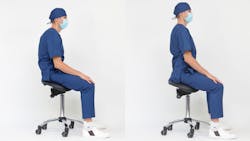You've got a saddle seat. But how does it work?
Be sure to read Anne Guignon's related article, Saddle seating: Choosing the right design for the right reasons
Saddle stools are very popular. When properly fitted and adjusted, saddle stools support an ergonomic seating style called declined seating. If you’re not familiar with the term “declined seating,” you may know it as elevated seating. In traditional seating, the user sits with their thighs parallel to the floor. In elevated seating the seat pan is tipped slightly forward, and the user sits with their hips higher than their knees.
Elevated seating supports the thighs and buttocks and maintains a healthy, neutral lumbar curve in the spine. It is a gift in that the body receives the benefits of standing and sitting at the same time.
Saddle stool seats have different shapes than traditional square or round seats—oval, triangular, and trapezoidal. They can look like a western or modified English horse saddle, a mini balance beam from gymnastics, or two oval disks perched side-by-side.
The overall goal
A properly fitted saddle reduces stressful posture and brings the user closer to the workstation, minimizing reaching distance and allowing the shoulders to relax. Other postural benefits include keeping the upper arms close to the torso and forearms parallel to the floor, which eliminates the dreaded chicken wing elbow and reduces overall musculoskeletal stress.
You should adjust your saddle first and then adjust the patient chair. Then, place frequently used tools and supplies close to you to minimize unnecessary reaching. This creates a safe working zone and allows you to make minor adjustments to accommodate various patient sizes.
More by Anne Guignon
Disrupting pathogens: Patient engagement strategies that support success
The changing landscape: Hygienists are becoming serious purchasers
Saddle height: The first critical adjustment
Good saddles contain both a height adjustment lever and a seat pan pitch mechanism. These controls typically attach to the hydraulic cylinder housing, which is located on the underside of the seat.
A properly adjusted saddle will be set higher than a traditional operator stool. To learn if it’s adjusted properly, the seat height should be around two inches below the groin when you stand next to the saddle. The correct height makes it easy to get on and off the saddle, positions the hips higher than the knees, and maintains an optimal lumbar curve.
With the seat pan at an optimal height, stand behind the saddle. Grasp the seat pan with one hand and mount the saddle from the back or the side. This technique provides complete control and prevents the saddle from scooting away unexpectedly. The process may seem odd, but it will become second nature after a few practice sessions.
Using a tripod stance
Most of us were taught to keep our legs close together when sitting in a traditional chair. Saddle seating is different and requires the user to sit in a tripod configuration with the feet flat on the floor and the legs spread apart. The actual width depends on the seat pan design, which ranges from a few inches to shoulder-width apart.
Balance your weight evenly across the entire seat pan to evenly support the thigh and buttocks. For optimal comfort, avoid sitting on the front rim. The saddle needs to support the thighs, not cut off the circulation in the back of the leg.
Finalizing the fit: Seat pan tilt
The next step is to create the ideal seat pan tilt. Saddle seats should have a slight forward and downward tilt, a feature that allows the hips to be higher than the knees. A 5- to 15-degree forward tilt works for most people. The tilt may feel strange for a first-time saddle user, so it’s important to stick with the process.
Sit on the saddle and unlock the tilt mechanism while keeping your feet flat on the floor and your weight balanced across the seat. Gently shift your torso backward or forward until the seat feels balanced. When you hit the “sweet spot” balance, the spine will now fully support the torso. Repeat the steps until the saddle seems natural, then relock the tilt mechanism. This can take a few tries to find the perfect tilt, but the adjustment quickly becomes intuitive.
Testing and positioning
It’s easy to test the adjustments. This is an especially important step if you’re sharing the saddle with someone else. While sitting on the saddle, raise your feet off the floor and point your toes at the wall behind you. A properly adjusted saddle will feel balanced. If the seat pitch is off, you will instinctively lean forward or backward trying to stay balanced. If this happens, repeat the adjustment settings.
Saddle seating is successful in every clock position except eight and four. To avoid unnecessary twisting at the waist, sit directly facing the patient. This encourages even weight distribution.
The devil is in the details
Saddles are a tool, not a miracle device, so stop and take a breath. Saddle seating uses different muscles and bones, so listen to your body. It takes time to acclimate. The moment it feels annoying, switch to your old seating for 30 minutes or so. Then get back on and strive to sit on it for about 15 to 30 minutes longer. Alternating gives your body time to learn the new system. It typically takes a few weeks to fully acclimate.
While it’s critical to not sit on the front rim, plus-sized clinicians should know there is nothing wrong with having a bit of backside extend beyond the rear portion of the seat. The key is having your sit bones supported. There are many different saddle seat pan shapes and sizes, so don’t let this detail deter you from using a saddle.
Some people complain about hip discomfort and others feel that saddles create too much pressure in the pelvic area. Hip discomfort is a sign that the seat pan is either too narrow or too wide for the user. Pelvic pressure is common with saddles that are bulky at the front end. Sometimes the pressure can be eliminated by refining the seat pan tilt, but typically pelvic pressure comes from using a design created for workers who sit in a more upright posture than for someone in dentistry.
An improper seat pan tilt or slick scrub fabric can contribute to the sensation of falling off. On occasion a user complains about inner thigh pressure, which can be a symptom of too much foam padding on the saddle or an improper height or tilt. Finally, some people say saddles cause skin irritation. This means the saddle needs adjusting or the clinician is using their inner thigh muscles to keep from falling off.
Clinicians who follow these suggestions love their saddles and feel healthier. Who doesn’t want to be elevated every time they work?
About the Author
Anne Nugent Guignon, MPH, RDH, CSP
ANNE NUGENT GUIGNON, MPH, RDH, CSP, has received numerous accolades over four decades for mentoring, research, and guiding her profession. As an international speaker and prolific author, Guignon focuses is on the oral microbiome, erosion, hypersensitivity, salivary dysfunction, ergonomics, and employee law issues. She may be contacted at [email protected].

